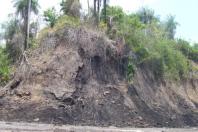Apartheid Oil
Apartheid Oil
Crude oil trapped in shale could transform Israel into energy powerhouse
JERUSALEM—Major offshore gas strikes in 2009 and 2010 may soon convert Israel into a gas exporting country with self-sufficient energy. But perhaps more important than the gas under the sea is the mock crude trapped in husk dry sands and rock hard shale, reserves which could push Israel into the upper echelons of recoverable oil on the planet. Israel’s reliance on others for energy supplies has long been a weakness, both economically and militarily.
What promises to be the most energy intensive form of oil recovery on the planet could reinforce Israel's military might, while presenting a new threat to scarce water resources and the climate.
New estimates show that there are 250 billion barrels of recoverable mock (or synthetic) crude oil, possibly even more, in locations throughout Israel. By way of comparison, Canada has just under 200 barrels of oil, including recoverable tar sands while Saudi Arabia is said to have 260 barrels.
The announcement of these major oil finds comes on the heels of the discovery of the contested Leviathan offshore gas field in the Mediterranean Sea, estimated to hold between 16 and 30 trillion cubic feet of natural gas.
The Leviathan field was discovered by Texas-based Noble Energy Inc. in June 2010. The discovery is disputed by Lebanon, which brought a complaint to the United Nations alleging Israeli slant drilling off the Lebanese coast following the 2006 aerial war. Further complicating matters is the other major natural gas play in the region, which lies beneath the recognized maritime territory of the Gaza Strip.
“Israel [will] never buy gas from Palestine,” declared Ariel Sharon in 2001, after the Palestinian Authority signed 25-year development leases with European energy companies. Palestinian control over their own gas was challenged in a 2003 Israel Supreme Court case that has yet to be resolved.
British Gas Group was close to striking a development deal on the Gaza deposit, and was planning to pipe gas through to Egypt when, in 2006, UK Prime Minister Tony Blair allegedly intervened to prevent sending the gas south, in the interest of Israel. In the following year, Israeli Prime Minister Ehud Olmert issued a proposal to buy the $4 billion worth of gas found in the Gaza deposit, with $1 billion in profits going to the Palestinian Authority (PA). The Israeli cabinet approved the proposal, and bypassed the newly-elected Hamas government in Gaza altogether.
The proposal eventually fell through because various military and security advisers warned a gas deal with the PA would pose a security risk to Israel. Soon after, British Gas Group closed their office in Israel and announced on their website that they were “...evaluating options for commercialising the gas.” Perhaps on the advice of retired high-ranking Israeli Defence Forces officials, British Gas Group ceded their field license, so as to no longer involve the Palestinian Authority.
Israeli interest in the Gaza deposit didn’t end then. In November 2008, the Israel Ministry of Finance and the Ministry of National Infrastructures instructed the Israel Electric Corporation to enter into negotiations with British Gas with hopes of purchasing natural gas from British Gas’s offshore concession in Gaza, according to a press release by Boycott Israel UK.
These instructions came approximately one month before Operation Cast Lead, or the Gaza War, and might have played a role in stalling an official Israeli attack on Gaza.
"It is possible that the prospect of a major natural gas transaction with the Palestinians has been a factor in the Israeli cabinet's refusal to launch a Defensive Shield II operation in Gaza,” wrote retired Israeli Lieutenant General Moshe Yaalon, only months before the Operation Cast Lead bombing of the Gaza Strip.
Together with the Leviathan deposits, the natural gas fields off of Gaza's shores represent reserves that could easily meet Israel's internal electrical energy needs and turn the Zionist state from net importer to an exporter of energy. But the importance of the gas deposits may pale in comparison to the more recent development of technology for recovering tar sands and shale oil. In fact, given the massive energy inputs required to extract oil from shale, the Leviathan and Gazan gas fields may become an integral part of supplying the energy for this massive heavy oil project.
Israel's massive oil shale deposits vary in form from petrified kerogen rock to bituminous formations that have the texture and appearance of the tar sands common to places like Alberta, Canada.
Israel Energy Initiatives (IEI) announced in March 2011 a project to transform shale into oil. The project will use a combination of technologies already in use in Canada's tar sands and newer conceptual technology developed in Colorado's vast oil shale deposits. If it proceeds, the shale oil extraction in Israel project could permanently alter the political and atmospheric climate of the Middle East.
IEI is a subsidiary of the much larger Israeli Data Technologies (IDT), a corporation that already dominates Israel's economic landscape and is led by IDT Chairman Howard Jonas. Along for the ride on this venture are media mogul Rupert Murdoch and former US vice-president Dick Cheney, along with many other notables.
Approximately 15 per cent of the landmass of UN-defined Israel overlays oil shale deposits. In fact, Israel has already exported their know-how to the Alberta tar sands: Ormat, an Israeli firm, has set up shop with patented energy technology in Alberta under the name Opti. Opti teamed up with Nexen in Canada to launch an in-house technique of burning the waste gunk produced through extraction in order to provide energy for the extraction operation itself. At the end of July 2011, Opti (and their interests in Alberta's tar sands) was sold to China National Offshore Oil Corp.
Not unlike the seismic shift that kicked the long dormant Alberta tar sands into high gear following the war on Iraq and cumulative rise in oil prices that coincided with the Katrina disaster in the Gulf of Mexico, the latest announcements out of Israel are staggering.
The oil shale proposal that is closest to approval is a short drive southwest of Jerusalem, a pastoral area of Kibbutzes and small villages that historians believe was the backdrop for the biblical battle between David and Goliath. The area doesn't feel anything like the oil boomtown of Fort McMurray, Alberta, or even anything close to much of the Middle East, but more like parts of western Canada's Okanogan Valley.
In the sunny backyard of a house in a gated community, Lia Tarachansky of the Real News Network interviewed Chagit Tishler about the proposed oil shale project while myself and a Palestinian man from a Jerusalem neighbourhood listened and drank tea.
“It's the biggest license even given to a private company in Israel,” said Tishler, who works with the organization Save Adullam, which is made up of local residents who oppose the IEI pilot project. The license was granted under the Oil Law, said Tishler, which is essentially a free entry law dating from 1952, which prioritizes oil and gas exploration over farms, parks or historical sites.
“The area could be ruined completely. This area is the last area in the centre of Israel that remains an open area and a green area, and has a lot of archaeological sites that are important not only to Israelis but to the rest of the world,” she said, before listing historical sites in the vicinity. Known as the Elah Valley, the area was re-settled only a couple of years after the Nakba in 1948 by primarily North African Mizrahi Jews. To this day, they and others use the valley for food crops and Israeli wine.
IEI's planned operations in the Elah Valley include digging five kilometres of trenches through farms and vineyards to expose the shale rock, which would then be heated until the kerogen and other organic materials held inside it are bled out of the rock, producing a basic crude substance. Much like tar sands bitumen, this substance will still need to go through an upgrading process before refining.
If carried out as planned, IEI’s project would constitute one of the least energy efficient forms of oil production ever devised. Three to five gigawatts of electricity would be used to produce a single barrel of shale-based oil, according to Save Adullam. Heating the shale, which takes place for months at a time, could release at least 15 million tons of CO2 into the atmosphere. No other extraction process in conventional oil or even tar sands involves a heating process this extensive, nor is any as carbon intensive. This carbon release takes place even before refining, let alone consumption.
Regardless, for Israel, these reserves represent a local supply that cannot be blockaded. IEI states that the petroleum from this shale produces a light synthetic crude nearly perfect for converting to jet fuel.
Thus far, groups like Save Adullam who wish to stop this project have failed to make alliances with other communities living with the threat of oil shale extraction. The focus of Save Adullam is to demand a repeal of the 1952 oil law. Their allies are inside the Knesset and others within the Israeli state, including the Jewish National Fund (JNF).
Though the first lands slated for large scale development projects have religious and biblical resonance, there are also mining projects that will spread across the traditional territory of Bedouin Palestinians in various parts of the Negev Desert. The majority of the surface oil shale, which is similar in composition to the Albertan tar sands, sits in the northern part of the desert. In addition, mining for oil shale, which is burned for electricity, has already taken place in the deep south of the desert, close to Eliat.
The Mishor Rotem Basin is on the west bank of the Dead Sea, and an oil shale deposit straddles both sides of the border between the state of Israel and the Hashemite Kingdom of Jordan. In 2006 the JNF concluded that Israel was using 25 per cent more water than was sustainable (this includes the almost 90 per cent of the water diverted from Palestinians in the West Bank).
In Zionist settlements and recognized Bedouin villages in the Negev, cancer rates are already considerably higher than in the rest of the Jewish state. Pollution from oil shale developments in any form would undoubtedly contribute to increasing overall contamination. In addition, the bulk of the Negev desert is also a training ground and “free fire zone” for the air force and military—already a massive environmentally destructive force at play.
Israel's laws make it nearly impossible for non-Jewish citizens of Israel to exact equal rights in almost any field, even within Israel. Bedouins are seeing these problems deepen—primarily upon the orders of the JNF, and carried out by riot squads and the IDF—with JNF-led “making the desert bloom” projects, attacking and bulldozing entire villages (some over 25 times in the last year) to facilitate “forest planting”; and forced re-settlement into government planned townships.
Bedouin communities traditionally linked with the land who wish to stop the intrusion of oil shale and its toxic consequences will likely need to think beyond strategies that simply try to undo laws written by the Zionist state, and they aren't likely to find allies in the JNF.
And in yet another parallel to Canada, the vast offshore gas deposits claimed by Israel—mainly but not exclusively the Leviathan field—could serve the same vital role for energy input of oil shale developments that natural gas plays in the Athabasca tar sands. Israel already has a water crisis, but it looks like it might see fit to exacerbate that problem in the push for energy independence.
This article is the first in a four part series examining unconventional oil deposits in the Middle East and North Africa. The series was originally published at http://mediacoop.ca
http://www.dominionpaper.ca/articles/4276


